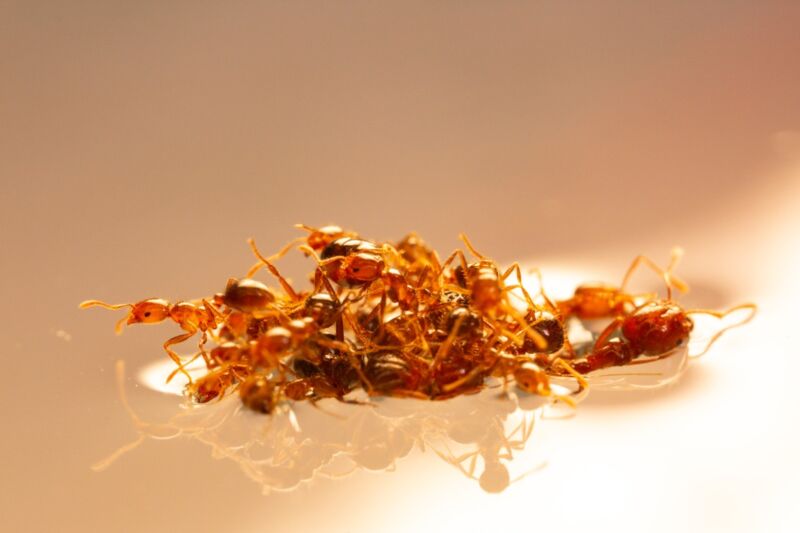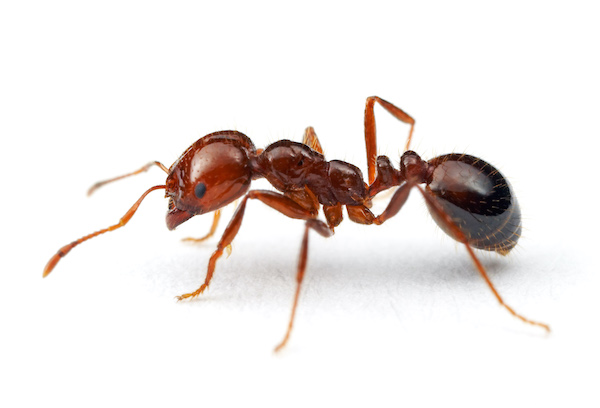
Fire ants might be the scourge of southern states like Georgia and Texas, but scientifically, they are endlessly fascinating as an example of collective behavior. A few fire ants spaced well apart behave like individual ants. But pack enough of them closely together, and they act more like a single unit, exhibiting both solid and liquid properties. They can form rafts to survive flash floods, arrange themselves into towers, and you can even pour them from a teapot like a fluid.
"Aggregated, they can almost be thought of as a material, known as 'active matter,'" said Hungtang Ko, now a postdoc at Princeton University, who began studying these fascinating creatures as a Georgia Tech graduate student in 2018. (And yes, he has been stung many, many times.) He's a co-author of two recent papers investigating the physics of fire ant rafts. The first, published in the journal Bioinspiration and Biomimetics (B&B), investigated how fire ant rafts behave in flowing water compared to static water conditions.
The second, accepted for publication in Physical Review Fluids, explored the mechanism by which fire ants come together to form the rafts in the first place. Ko et al. were somewhat surprised to find that the primary mechanism appears to be the so-called "Cheerios effect"—named in honor of the tendency for those last remaining Cheerios floating in milk to clump together in the bowl, either drifting to the center, or to the outer edges.
A single ant has a certain amount of hydrophobia, i.e., the ability to repel water. This property is intensified when they link together, weaving their bodies much like a waterproof fabric. The ants gather up any eggs, make their way to the surface via their tunnels in the nest, and as the flood waters rise, they chomp down on each other's bodies with their mandibles and claws until a flat raft-like structure forms. Each ant behaves like an individual molecule in a material—say, grains of sand in a sand pile. The ants can accomplish this in less than 100 seconds. Plus, the ant raft is "self-healing": it's robust enough that if it loses an ant here and there, the overall structure can stay stable and intact, even for months at a time.
In 2019, Ko and colleagues reported that fire ants could actively sense changes in forces acting upon their floating raft. The ants recognized different fluid flow conditions and can adapted their behavior accordingly to preserve the raft's stability. A paddle moving through river water will create a series of swirling vortices (known as vortex shedding), causing the ant rafts to spin. These vortices can also exert extra forces on the raft, sufficient to break it apart. The changes in both centrifugal and shearing forces acting on the raft are quite small—maybe 2 percent to 3 percent the force of normal gravity. Yet somehow, the ants can sense these small shifts with their bodies.
Earlier this year, researchers at the University of Colorado, Boulder, identified a few simple rules that seem to govern how floating rafts of fire ants contract and expand their shape over time. As we reported at the time, sometimes the structures would compress into dense circles of ants. Other times, the ants would start to fan out to form bridge-like extensions (pseudopods), sometimes using the extensions to escape the containers.
How did the ants achieve those changes? The rafts essentially comprise two distinct layers. Ants on the bottom layer serve a structural purpose, making up the stable base of the raft. But the ants on the upper layer move freely on top of the linked bodies of their bottom-layer brethren. Sometimes ants move from the bottom to the upper layer or from the upper to the bottom layer in a cycle resembling a doughnut-shaped treadmill.
Ko et al.'s B&B study is somewhat related in focus, except the Boulder study looked at the broad collective dynamics rather than interactions between individual ants. "There are thousands and thousands of ants in the wild, but nobody really knows how a pair of ants would interact with each other, and how that affects the stability of the raft," Ko told Ars.
With such large rafts, repeatability can be an issue. Ko wanted to gain a little more control over his experiments and also study how the ants adapted to different flow scenarios in water. He found that the ants employ an active streamlining strategy, changing the shape of the raft to reduce drag. "So maybe it takes less force, or less metabolic cost, to hold onto the vegetation than if they stuck with the original larger pancake shape," said Ko.



3175x175(CURRENT).thumb.jpg.b05acc060982b36f5891ba728e6d953c.jpg)

Recommended Comments
There are no comments to display.
Join the conversation
You can post now and register later. If you have an account, sign in now to post with your account.
Note: Your post will require moderator approval before it will be visible.